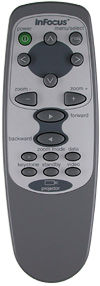InFocus ScreenPlay 110 One-Chip DLP Projector Page 2
 After I calibrated the S-video input for DVD and the component video input for HDTV, I sat back and watched a variety of DVD material, as well as HD feeds off of my DISH Network satellite system. The ScreenPlay 110's color fidelity was the first thing that struck me. The natural-looking skintones and the color rendition of all of the material I watched impressed me. There are a few reasons for this impressive picture quality. For one, the ScreenPlay 110's color decoder is excellent. Also, you can tweak the gray scale to near perfection. Unlike that of CRT-based displays, the ScreenPlay 110's white-field uniformity, or the evenness of color across the screen, is outstanding. The Faroudja video processing certainly doesn't hurt the projector's performance. The 3:2 pulldown helps eliminate the jaggy and motion artifacts that are created by the frame-rate difference between film (24 frames per second) and video (30 fps).
After I calibrated the S-video input for DVD and the component video input for HDTV, I sat back and watched a variety of DVD material, as well as HD feeds off of my DISH Network satellite system. The ScreenPlay 110's color fidelity was the first thing that struck me. The natural-looking skintones and the color rendition of all of the material I watched impressed me. There are a few reasons for this impressive picture quality. For one, the ScreenPlay 110's color decoder is excellent. Also, you can tweak the gray scale to near perfection. Unlike that of CRT-based displays, the ScreenPlay 110's white-field uniformity, or the evenness of color across the screen, is outstanding. The Faroudja video processing certainly doesn't hurt the projector's performance. The 3:2 pulldown helps eliminate the jaggy and motion artifacts that are created by the frame-rate difference between film (24 frames per second) and video (30 fps). Chapter 4 of Hollow Man, in which the scientists make the ape visible again, showed off the ScreenPlay 110's clarity and detail. I watched "Montage of Images" from Video Essentials in the 4:3 aspect ratio to see if the projector exhibited any light spray, which is something quite common with 4:3-based one-chip DLP projectors. While there is some light spray, it's not as pronounced as it is with some 800-by-600 one-chip DLP projectors I've seen. There's a deep black border about 6 inches wide around the edge of the picture when the projector is in 4:3 mode, and there's a 3- or 4-inch area of light spray around the black border (which is somewhat distracting) on a 16:9 screen. You will notice a similar (although much-less-pronounced) effect when you use the widescreen modes. To minimize the light-spray issue, use the ScreenPlay 110 with a 4:3 screen and let the projector create a widescreen aspect ratio inside the 4:3 area, as opposed to the other way around.
In terms of picture quality, the biggest problem that one-chip DLP projectors have is with the black level. They do not reproduce blacks anywhere near as dark as a CRT-based display will. This is particularly true of 4:3 one-chip units like the ScreenPlay 110. Dark scenes, whether with DVD material or HD sources, were plagued with lots of noise and dark grays, instead of true blacks. I watched most of Arthur in 1080i via DISH Network and found the black level to be just as problematic with HD as it was with DVD material. In fact, dark video of any kind looked very much the way it does on a plasma panel, which suffers from the same inability to reproduce a true black. I also noted that some low-level noise is visible in bright scenes, but it's not nearly as objectionable as it is in darker scenes. In fairness to InFocus, this problem is inherent to all 800-by-600 and 1,024-by-768 4:3 one-chip DLP projectors. The new 1,280-by-720 16:9 one-chip DLP projectors are much better in this regard but still aren't up to the level of a CRT-based display. With that said, bright scenes from both HD and DVD sources looked quite good through the ScreenPlay 110.
InFocus has done a great job with the ScreenPlay 110. Its video processing (courtesy of Faroudja), color decoding, and excellent gray-scale tracking combine to produce excellent color fidelity with a minimum amount of artifacts. At $4,999, the ScreenPlay 110 is definitely in the entry-level category; however, when you compare its performance with that of most of its competition, it's clearly a notch above the pack. If you're on a tight budget but desire a big front-projection home theater, the ScreenPlay 110 is certainly worth a serious look.

HIGHLIGHTS
• Excellent value in the entry-level front-projection category
• Very good video processing and overall performance from a native 4:3 one-chip DLP projector





























































